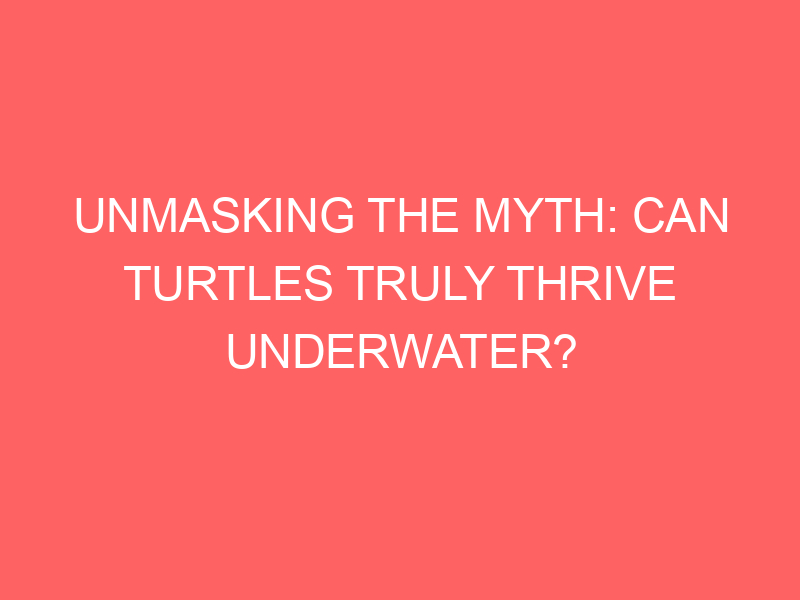
Introduction: Debunking Turtle Myths
There’s a fascinating world beneath the shell of a turtle. However, many myths and misconceptions cloud our understanding of these unique creatures. In this blog post, we aim to debunk some of these myths and shed light on the truth about turtles, particularly their aquatic life.
- Common misconceptions about turtles
- Importance of understanding turtle aquatic life
Many people believe that turtles are slow, lazy, and can live without food or water for long periods. Some even think that turtles can come out of their shells like hermit crabs. These are all myths. Turtles are active creatures, especially in water. They need a balanced diet and clean water to thrive. And no, they cannot leave their shells as it’s a part of their skeletal system.
Understanding the aquatic life of turtles is crucial for their conservation. Turtles play a significant role in maintaining healthy aquatic ecosystems. They help control the population of certain pests and contribute to nutrient cycling. By debunking myths about turtles, we can better appreciate their role in nature and work towards their protection.
In the following sections, we will delve deeper into the underwater survival of turtles, separate fact from fiction, and present a case study on aquatic turtle survival. Stay tuned to uncover the fascinating truth about turtles.
Turtle Underwater Survival: The Basics
Understanding the underwater survival capabilities of turtles is fascinating. Let’s delve into the basics of how these remarkable creatures manage to survive and thrive in underwater environments.
- Overview of turtle underwater capabilities
Turtles are known for their impressive underwater capabilities. They are built for life in the water, with streamlined bodies and webbed feet that allow them to swim efficiently. Turtles can stay underwater for extended periods, ranging from 4 to 7 hours, depending on the species and their activity level. This ability is due to their slow metabolism and unique respiratory adaptations.
It’s important to note that not all turtles have the same underwater capabilities. Aquatic turtles, such as the red-eared slider and the painted turtle, are excellent swimmers and spend most of their lives in the water. On the other hand, terrestrial turtles, like the box turtle, are not built for swimming and can drown if placed in deep water.
- How turtles breathe underwater
One of the most intriguing aspects of turtle biology is how they breathe underwater. Unlike humans, turtles have adapted to extract oxygen directly from the water. They do this through a process called ‘cloacal respiration’. The cloaca is an opening in a turtle’s rear end that serves multiple functions, including waste removal and reproduction. But, in some species of turtles, it also plays a crucial role in underwater respiration.
When turtles are underwater and relaxed, they can pump water in and out of their cloaca, allowing them to extract oxygen directly from the water. This process enables them to stay submerged for extended periods without coming up for air. However, it’s important to note that not all turtles can breathe this way. Some species, especially those that spend more time on land, rely primarily on their lungs for breathing.
Understanding the underwater survival capabilities of turtles helps us appreciate these creatures’ adaptability and resilience. It also underscores the importance of protecting their habitats to ensure their survival for generations to come.
Myths about Turtles: Separating Fact from Fiction
There are many misconceptions about turtles and their ability to survive underwater. Let’s debunk some of these myths and learn the truth about these fascinating creatures.
- Myth 1: Turtles can’t breathe underwater
- Myth 2: Turtles can’t survive long underwater
- Myth 3: All turtles are the same in terms of underwater survival
Contrary to popular belief, turtles can breathe underwater, but not in the same way as fish. Turtles have lungs, not gills, so they need to surface to breathe. However, they have adapted to stay underwater for extended periods by slowing their heart rate and reducing their need for oxygen. Some turtles can even absorb a small amount of oxygen through their skin, throat, and cloaca while submerged.
This is another common myth. Turtles are remarkable swimmers and can stay underwater for several hours at a time. Some species, like the painted turtle, can even hibernate underwater for the entire winter! They do this by slowing their metabolism and using stored energy reserves.
Not all turtles are created equal when it comes to underwater survival. Different species have different adaptations. For example, sea turtles can stay underwater for several hours while hunting or sleeping, while most land-based turtles can only hold their breath for 10-15 minutes. It’s important to understand these differences, especially if you’re considering a turtle as a pet.
Now that we’ve debunked these myths, we can appreciate turtles and their unique adaptations even more. Remember, understanding and respecting our wildlife is key to their survival and our planet’s health.
| Myth | Fact |
|---|---|
| Turtles can’t breathe underwater | Turtles can breathe underwater, but they need to surface for air as they have lungs, not gills. |
| Turtles can’t survive long underwater | Some species of turtles can stay underwater for several hours, and some can even hibernate underwater during winter. |
| All turtles are the same in terms of underwater survival | Different species of turtles have different adaptations for underwater survival. |
Case Study: Aquatic Turtle Survival
Case Study 1: The Leatherback Sea Turtle
Let’s dive into the fascinating world of the Leatherback Sea Turtle, a remarkable aquatic creature that defies many common myths about turtle survival.
- Overview of the Leatherback’s Underwater Capabilities
The Leatherback Sea Turtle, known scientifically as Dermochelys coriacea, is a marvel of underwater survival. Unlike most turtles, Leatherbacks can dive deeper than 1000 meters and stay underwater for up to 85 minutes! They have a unique, flexible shell that allows them to withstand the pressure at these depths.
Leatherbacks are also the largest of all living turtles, reaching lengths of up to 7 feet and weights of over 2000 pounds. Their size and strong flippers make them powerful swimmers, capable of crossing entire oceans.
- How the Leatherback’s Survival Debunks Common Turtle Myths
Many people believe that turtles are slow, clumsy, and easy prey. The Leatherback Sea Turtle proves these myths wrong. With their deep-diving abilities, they can escape predators and find food in places where other turtles can’t reach. Their size and strength also make them formidable opponents for any predator.
Another common myth is that turtles can’t survive in cold water. But Leatherbacks are known to thrive in the cold waters of the North Atlantic, thanks to a unique system of blood vessels that helps them conserve heat.
These facts about the Leatherback’s survival show us that turtles are much more resilient and adaptable than we often give them credit for.
Stay tuned for more case studies that will further debunk common myths about turtle survival and reveal the incredible abilities of these amazing creatures.
Case Study 2: The Green Sea Turtle
Let’s dive into the world of the Green Sea Turtle, a fascinating creature that busts many common turtle myths with its survival abilities.
- Overview of the Green Sea Turtle’s Underwater Capabilities
The Green Sea Turtle, also known as Chelonia mydas, is a marvel of nature. Unlike many other turtles, the Green Sea Turtle is primarily an aquatic creature, spending most of its life underwater. It can stay submerged for hours at a time, thanks to its unique ability to slow down its heart rate to conserve oxygen.
| Green Sea Turtle’s Underwater Capabilities |
|---|
| Ability to stay underwater for hours |
| Can slow down heart rate to conserve oxygen |
- How the Green Sea Turtle’s Survival Debunks Common Turtle Myths
One common myth about turtles is that they are slow and sluggish, both on land and in water. However, the Green Sea Turtle debunks this myth with its impressive swimming speed, reaching up to 35 miles per hour in the water. This speed not only allows them to escape predators but also to travel long distances in search of food and mates.
Another myth is that turtles can’t survive without constant access to air. But the Green Sea Turtle’s ability to stay underwater for extended periods, even while sleeping, proves this myth wrong. They have adapted to their aquatic environment in such a way that they can extract oxygen directly from the water when needed.
| Myths Debunked by the Green Sea Turtle |
|---|
| Turtles are slow and sluggish |
| Turtles can’t survive without constant access to air |
In conclusion, the Green Sea Turtle is a remarkable creature that challenges many common misconceptions about turtles. Its underwater capabilities and survival skills are a testament to the adaptability and resilience of nature’s creatures.
Underwater Survival of Turtles: Key Takeaways
In this article, we have explored the fascinating world of turtles and their underwater survival abilities. Let’s summarize the key points we have learned.
- Understanding turtle underwater living conditions
- Recognizing the diversity in turtle underwater survival abilities
- Importance of debunking myths for turtle conservation
Turtles are remarkable creatures that have adapted to a variety of underwater conditions. They can live in both saltwater and freshwater environments, and their bodies are designed to handle the pressures of deep diving. Some species can even hibernate underwater during the winter, slowing their metabolism to conserve energy.
Not all turtles are the same. Different species have different survival abilities and behaviors. For instance, the Leatherback Sea Turtle can dive deeper than any other turtle, reaching depths of over 1000 meters! On the other hand, the Green Sea Turtle is known for its long-distance migration, travelling thousands of miles to reach its nesting grounds.
There are many myths about turtles that can harm their conservation efforts. For example, the myth that turtles can come out of their shells like cartoon characters can lead to harmful human interactions. By debunking these myths, we can help protect turtles and their habitats.
By understanding the underwater survival abilities of turtles and debunking harmful myths, we can better appreciate these amazing creatures and contribute to their conservation. Remember, every turtle species plays a unique role in the ecosystem and deserves our respect and protection.
Conclusion: Unmasking the Myth
As we reach the end of our journey, it’s time to recap what we’ve learned and debunk the myths surrounding the underwater survival capabilities of turtles. Let’s unmask the truth and shed light on these fascinating creatures.
- Recap of turtle underwater survival capabilities
- Final thoughts on debunking turtle myths
Turtles are remarkable creatures with unique survival capabilities. They can stay underwater for extended periods, thanks to their slow metabolism and ability to absorb oxygen through their skin and throat lining. This is a fact, not a myth. Turtles’ underwater survival is a testament to their adaptability and resilience.
Throughout this article, we’ve debunked several myths about turtles. They do not breathe through their shells, nor do they have gills like fish. They are not slow swimmers, and they certainly do not hibernate underwater. These are all myths that have been propagated over time, but now we know better.
As we unmask the myth, we realize that turtles are far more fascinating and complex than we initially thought. They are a testament to nature’s ingenuity and adaptability. So, the next time you encounter a turtle, remember the facts and appreciate these wonderful creatures for what they truly are.














